一般现在时、现在进行时、一般过去式和一般将来时复习
文档属性
| 名称 | 一般现在时、现在进行时、一般过去式和一般将来时复习 |  | |
| 格式 | zip | ||
| 文件大小 | 723.1KB | ||
| 资源类型 | 教案 | ||
| 版本资源 | 外研版 | ||
| 科目 | 英语 | ||
| 更新时间 | 2013-09-09 09:21:52 | ||
图片预览

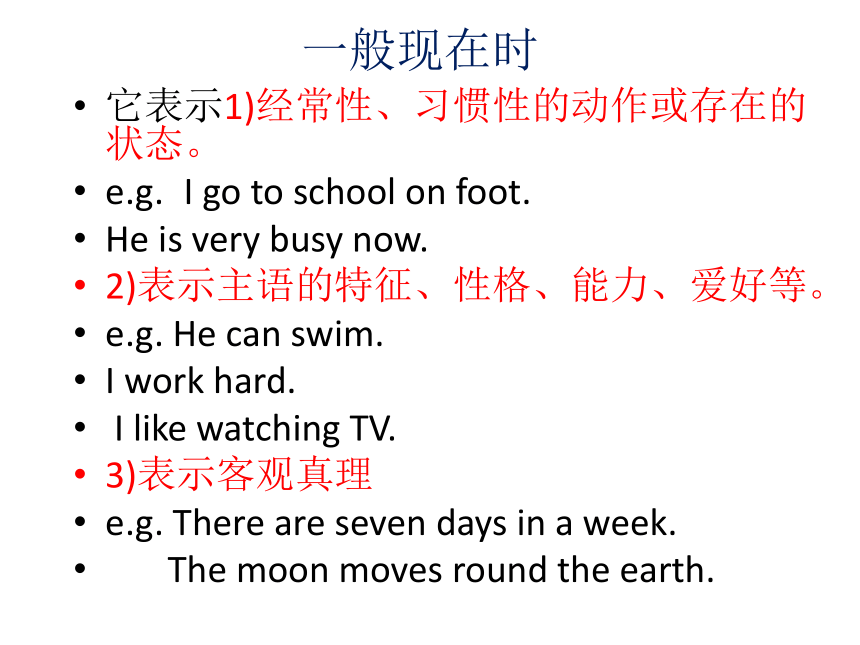
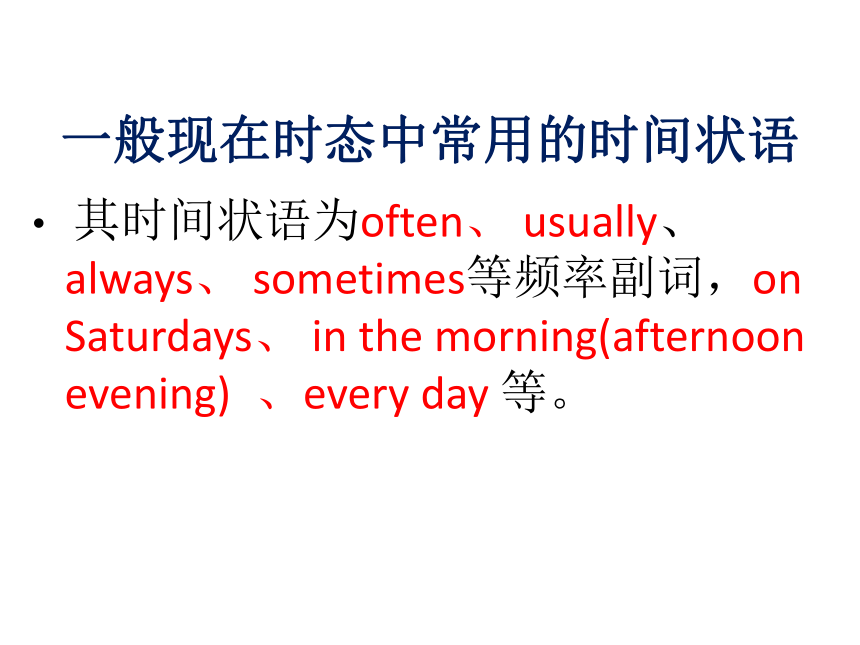



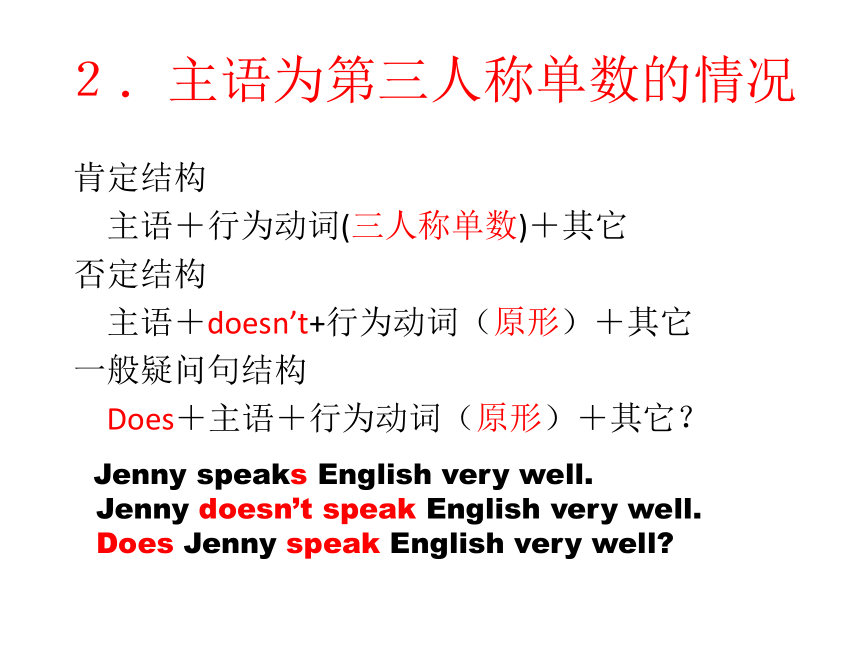
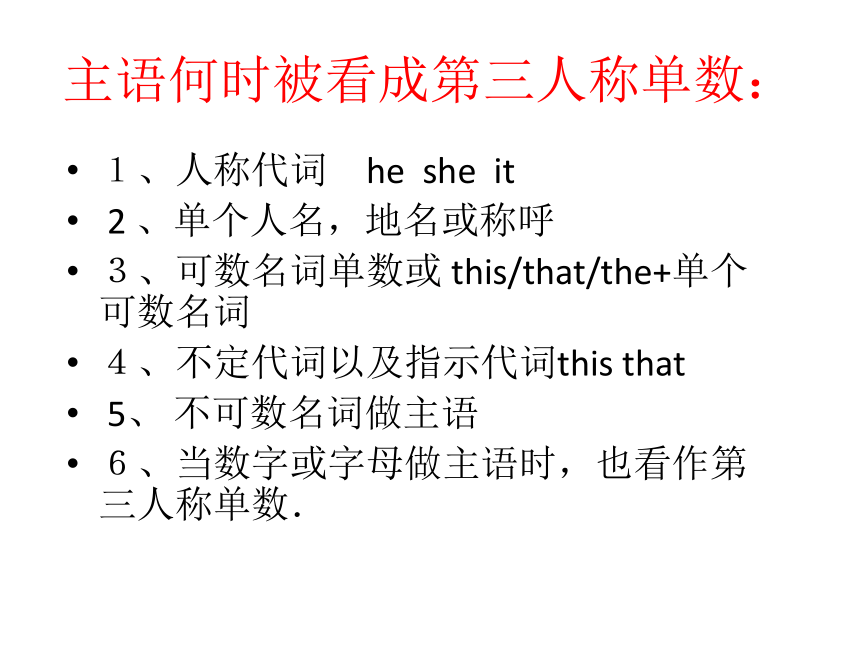
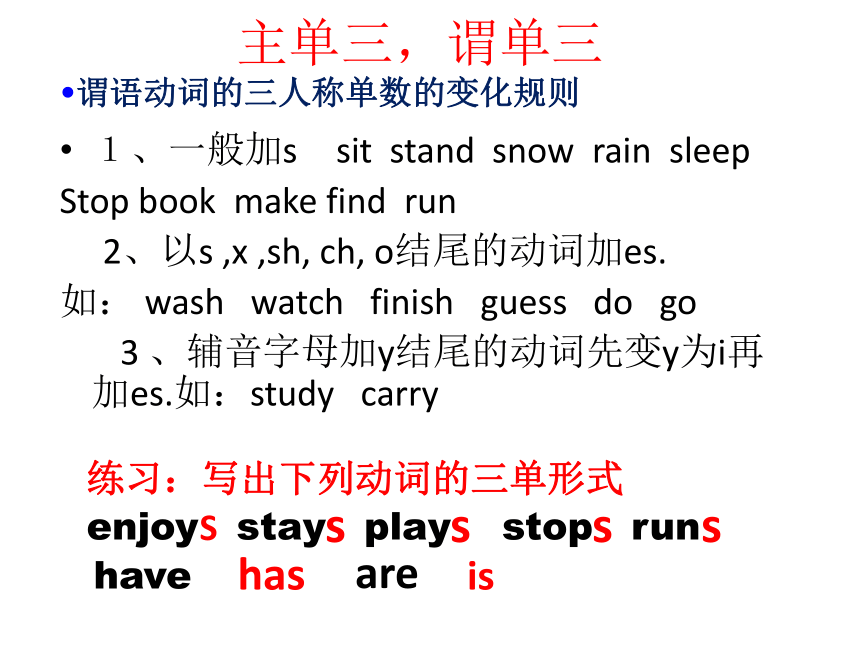
文档简介
课件26张PPT。复习
一般现在时 现在进行时 一般过去时一般将来时一般现在时它表示1)经常性、习惯性的动作或存在的状态。
e.g.? I go to school on foot.?
He is very busy now.
2)表示主语的特征、性格、能力、爱好等。
e.g. He can swim.?
I work hard.?
I like watching TV.
3)表示客观真理
e.g. There are seven days in a week.?
The moon moves round the earth.一般现在时态中常用的时间状语 其时间状语为often、 usually、 always、 sometimes等频率副词,on Saturdays、 in the morning(afternoon evening)? 、every day 等。? 第一种含be动词的一般现在时态 I am a teacher. She is a student.
She is Miss Li. She is friendly.
We are 14 years old. She is young.
含有be动词的句式变化要在be上做变化. ???? E.g. Danny is a good student. ???? Danny isn’t a good student.? ???? Is Danny a good student?第二种 含有行为动词的一般现在时态其结构通常为,“主语+谓语+其它”
这种情况又分两种,分为
1、主语不是第三人称单数的情况。
2、主语是第三人称单数的情况。 2.主语为非第三人称单数的情况肯定结构 主语+行为动词+其它
否定结构 主语+don’t+行为动词+其它
一般疑问句结构
Do+主语+行为动词+其它?
They have lunch at 12:00.?
They don’t have lunch at 12:00.??
Do they have lunch at 12:00?2.主语为第三人称单数的情况肯定结构
主语+行为动词(三人称单数)+其它
否定结构
主语+doesn’t+行为动词(原形)+其它
一般疑问句结构
Does+主语+行为动词(原形)+其它?
Jenny speaks English very well.?? Jenny doesn’t speak English very well. Does Jenny speak English very well? 主语何时被看成第三人称单数:1、人称代词 he she it
2 、单个人名,地名或称呼
3、可数名词单数或 this/that/the+单个可数名词
4、不定代词以及指示代词this that
5、 不可数名词做主语
6、当数字或字母做主语时,也看作第三人称单数. 主单三,谓单三1、一般加s sit stand snow rain sleep
Stop book make find run
2、以s ,x ,sh, ch, o结尾的动词加es.
如: wash watch finish guess do go
3 、辅音字母加y结尾的动词先变y为i再加es.如:study carry 谓语动词的三人称单数的变化规则
练习:写出下列动词的三单形式
enjoy stay play stop runhaveSsssshasareis现在进行时1、现在(说话的瞬间)正在进行或发生的动作,强调“此时此刻”。
E.g. He is reading . They are talking now.
2、当前一段时间内的活动或现阶段正在进行的动作。
E.g. They are working these days.
一般由look,listen,now, at this moment等时间状语做标志。其结构:be+现在分词. 肯定结构 be+doing
否定结构 be not +doing
一般疑问句结构 Be +主语+其它?
其句式变换都在be上做文章。
E.g. He is buying a bike.
???? Is he buying a bike?
? He isn’t buying a bike. 动词现在分词的变化规则大多是 动词原型+ing
Reading ,drinking, eating, meeting
thinking
特殊变化:1.以不发音的e结尾,去e加ing
Writing, making
2.重读闭音节要双写结尾的辅音字母加ing
Sitting swimming putting running
请写出下列动词的ing形式注意
play study
swim chat
begin eat
prefer
playingstudyingswimmingchattingbeginningeatingpreferring一般过去时一般过去时主要表示过去某时发生的动作或情况
1)过去某个时间所发生的动作或存在的状态。
e.g. I bought a new shirt yesterday.
He was a worker two years ago.
2)过去一段时间内,经常性或习惯性的动作。
e.g. When I was a child, I often played with fire.?
Li Lei always walked to school last term.
3)谈到已故人的情况时多用过去时。
e.g. Lu Xun was a great writer. 一般过去时态中常用的时间状语:
1、yesterday或由其构成的短语,e.g. yesterday morning;
2、由“last+时间”构成的短语, e.g. last year;
3、由"时间段+ago"构成的短语, e.g. three days ago;
另外,还有on the morning of Monday, just now等 其结构是"主语+动词的过去式"。 第一种 含有be动词的
I was 22 . We were good friends.
She was young and beautiful.
They were happy at the party.
其句式变化含有be动词的依然在be上做文章.
e.g. I was born in 1980.
? I was not born in 1980.?
Were you born in 1980? 第二种 含有行为动词的肯定结构
主语+行为动词(过去式)+其它
否定结构
主语+didn’t+行为动词(原形)+其它
一般疑问句结构
Did+主语+行为动词(原形)+其它?
动词的过去式be动词的过去式为was, were;
行为动词的过去式有规则变化和不规则变化两种,
规则变化有以下几种情况:
1)直接在动词原形末尾加-ed.
e.g. work-----worked; ask------asked;
2)以e结尾的动词只加-d.
e.g. arrive-----arrived; like-----liked.
3)末尾只有一个辅音字母的重读闭音节,应先双写这个辅音字母,再加-ed.
e.g. shop-----shopped; stopped
4)以"辅音字母+y"结尾的动词,先把y变成i,再加-ed. e.g. carry----carried; study------studied.有些动词变过去式是不规则的,e.g. fly------flew; break-----broke; teach-----taught. 这些需要象生单词一样记住.
练习:请写出下列动词的过去形式
put cut read
come go take
swim run begin
do play enjoy
stop
Play enjoy stop putcutreadcamewenttookswamranbegandidplayedenjoyedstopped一般将来时态构成 will+动词原形 和be going to+动词原形
一般将来时I: will +动词原形的用法:表从现在看来将要发生的事或存在的状态。
肯定句:主语+ will+动词原形------
There will be a computer on every desk in the future.
未来每个桌子上都将有一台电脑。
It will rain tomorrow. 明天将要下雨。
We will go to school on foot.
我们将步行去上学。一般疑问句:Will+主语+ 动词原形----- ?回答(Yes, sb will或 No, sb won’t)Will there be a computer on every desk tomorrow? Yes, there will. / No, there won’t.未来每个桌子上都将有一台电脑吗? 是的,将有。 / 不,将没有。
Will it rain tomorrow? Yes, it will. / No, it won’t.
明天将会下雨吗?是的, 将会。 / 不, 将不会。
Will we go to school by bus tomorrow? Yes, we will. / No, we won’t.
明天我们将乘公交车去上学吗? 是的,将会。 / 不,将不会。
否定句:主语+ will not(won’t)+动词原形—
There will not be a computer on every desk in the future.
= There won’t be a computer on every desk in the future. 未来每个桌子上都将没有一台电脑
It will not rain tomorrow. It tomorrow. 明天将不会下雨。
We will not go to school by bus. We to school by bus.
我们将不乘公交车去上学。
特殊疑问句:疑问词+一般疑问句?
一般将来时II: is/am /are going to + 动词原形的用法。
1、主要用来表示打算或计划要做某事, 主语是人。如:
She is going to learn Japanese next year.
There is going to be a football match tonight.
Dad and I are going to see Beijing opera this afternoon. 今天下午我和爸爸打算去看京剧。 We are going to have a meeting today. 今天我们要开会。??
I’m going to play the violin. 我打算拉小提琴。
She’s going to play the piano. 她打算弹钢琴。2、有迹象要发生的事 It’s going to be a fine day tomorrow. 明天将会是个好天。
Look at the sky, it is going to rain. 看天空,要下雨了。
I think it’s going to snow. 我看快要下雪了。
I’m not well today. I am afraid I am going to have a cold.
我今天不舒服,恐怕我要感冒了。
Look at the dark clouds, there is going to be a storm.
看看这些黑云,将有一场暴风雨
注:be going to 中的be动词要随着句子主语的人称或数的变化而变化。
一般将来时的一般疑问形式是: 把be (am, is, are)直接放于句首, some 改为any, and改为or, 第一二人称互换。简略答语中的动词要与主语保持一致。 I am not=I’m not.
一般将来时的否定形式是: be (am, is, are) + not going to + 动词原形
He is going to have a swim tomorrow.
(改为否定句)
→ He is not =(isn’t) going to have a swim tomorrow.
一般将来时态be going to+动词原形的特殊疑问句:
1. 问人 Who…?
I’m going to New York soon. →Who’s going to New York soon?
2. 问干什么 What … do?
My father is going to watch a race with me this afternoon. →What is your father going to do with you this afternoon?
3. 问什么时候 When…?
She’s going to go to bed at nine. →When is she going to bed?
4. 同义句: be going to = will
I am going to go swimming tomorrow(明天). = I will go swimming tomorrow.
在一般将来时中,常常会有表示将来的时间状语: tomorrow, next week, this afternoon等。
语法总结:
be going to, 跟“动原”, 计划、准备或打算;
表可能,有必然,通过现象来判断。
be 的形式要注意,它要随着人称变;
否定句,很简单,not 加在 be 后面;
疑问句,需牢记,be 应提到主语前
Thank you !
e.g.? I go to school on foot.?
He is very busy now.
2)表示主语的特征、性格、能力、爱好等。
e.g. He can swim.?
I work hard.?
I like watching TV.
3)表示客观真理
e.g. There are seven days in a week.?
The moon moves round the earth.一般现在时态中常用的时间状语 其时间状语为often、 usually、 always、 sometimes等频率副词,on Saturdays、 in the morning(afternoon evening)? 、every day 等。? 第一种含be动词的一般现在时态 I am a teacher. She is a student.
She is Miss Li. She is friendly.
We are 14 years old. She is young.
含有be动词的句式变化要在be上做变化. ???? E.g. Danny is a good student. ???? Danny isn’t a good student.? ???? Is Danny a good student?第二种 含有行为动词的一般现在时态其结构通常为,“主语+谓语+其它”
这种情况又分两种,分为
1、主语不是第三人称单数的情况。
2、主语是第三人称单数的情况。 2.主语为非第三人称单数的情况肯定结构 主语+行为动词+其它
否定结构 主语+don’t+行为动词+其它
一般疑问句结构
Do+主语+行为动词+其它?
They have lunch at 12:00.?
They don’t have lunch at 12:00.??
Do they have lunch at 12:00?2.主语为第三人称单数的情况肯定结构
主语+行为动词(三人称单数)+其它
否定结构
主语+doesn’t+行为动词(原形)+其它
一般疑问句结构
Does+主语+行为动词(原形)+其它?
Jenny speaks English very well.?? Jenny doesn’t speak English very well. Does Jenny speak English very well? 主语何时被看成第三人称单数:1、人称代词 he she it
2 、单个人名,地名或称呼
3、可数名词单数或 this/that/the+单个可数名词
4、不定代词以及指示代词this that
5、 不可数名词做主语
6、当数字或字母做主语时,也看作第三人称单数. 主单三,谓单三1、一般加s sit stand snow rain sleep
Stop book make find run
2、以s ,x ,sh, ch, o结尾的动词加es.
如: wash watch finish guess do go
3 、辅音字母加y结尾的动词先变y为i再加es.如:study carry 谓语动词的三人称单数的变化规则
练习:写出下列动词的三单形式
enjoy stay play stop runhaveSsssshasareis现在进行时1、现在(说话的瞬间)正在进行或发生的动作,强调“此时此刻”。
E.g. He is reading . They are talking now.
2、当前一段时间内的活动或现阶段正在进行的动作。
E.g. They are working these days.
一般由look,listen,now, at this moment等时间状语做标志。其结构:be+现在分词. 肯定结构 be+doing
否定结构 be not +doing
一般疑问句结构 Be +主语+其它?
其句式变换都在be上做文章。
E.g. He is buying a bike.
???? Is he buying a bike?
? He isn’t buying a bike. 动词现在分词的变化规则大多是 动词原型+ing
Reading ,drinking, eating, meeting
thinking
特殊变化:1.以不发音的e结尾,去e加ing
Writing, making
2.重读闭音节要双写结尾的辅音字母加ing
Sitting swimming putting running
请写出下列动词的ing形式注意
play study
swim chat
begin eat
prefer
playingstudyingswimmingchattingbeginningeatingpreferring一般过去时一般过去时主要表示过去某时发生的动作或情况
1)过去某个时间所发生的动作或存在的状态。
e.g. I bought a new shirt yesterday.
He was a worker two years ago.
2)过去一段时间内,经常性或习惯性的动作。
e.g. When I was a child, I often played with fire.?
Li Lei always walked to school last term.
3)谈到已故人的情况时多用过去时。
e.g. Lu Xun was a great writer. 一般过去时态中常用的时间状语:
1、yesterday或由其构成的短语,e.g. yesterday morning;
2、由“last+时间”构成的短语, e.g. last year;
3、由"时间段+ago"构成的短语, e.g. three days ago;
另外,还有on the morning of Monday, just now等 其结构是"主语+动词的过去式"。 第一种 含有be动词的
I was 22 . We were good friends.
She was young and beautiful.
They were happy at the party.
其句式变化含有be动词的依然在be上做文章.
e.g. I was born in 1980.
? I was not born in 1980.?
Were you born in 1980? 第二种 含有行为动词的肯定结构
主语+行为动词(过去式)+其它
否定结构
主语+didn’t+行为动词(原形)+其它
一般疑问句结构
Did+主语+行为动词(原形)+其它?
动词的过去式be动词的过去式为was, were;
行为动词的过去式有规则变化和不规则变化两种,
规则变化有以下几种情况:
1)直接在动词原形末尾加-ed.
e.g. work-----worked; ask------asked;
2)以e结尾的动词只加-d.
e.g. arrive-----arrived; like-----liked.
3)末尾只有一个辅音字母的重读闭音节,应先双写这个辅音字母,再加-ed.
e.g. shop-----shopped; stopped
4)以"辅音字母+y"结尾的动词,先把y变成i,再加-ed. e.g. carry----carried; study------studied.有些动词变过去式是不规则的,e.g. fly------flew; break-----broke; teach-----taught. 这些需要象生单词一样记住.
练习:请写出下列动词的过去形式
put cut read
come go take
swim run begin
do play enjoy
stop
Play enjoy stop putcutreadcamewenttookswamranbegandidplayedenjoyedstopped一般将来时态构成 will+动词原形 和be going to+动词原形
一般将来时I: will +动词原形的用法:表从现在看来将要发生的事或存在的状态。
肯定句:主语+ will+动词原形------
There will be a computer on every desk in the future.
未来每个桌子上都将有一台电脑。
It will rain tomorrow. 明天将要下雨。
We will go to school on foot.
我们将步行去上学。一般疑问句:Will+主语+ 动词原形----- ?回答(Yes, sb will或 No, sb won’t)Will there be a computer on every desk tomorrow? Yes, there will. / No, there won’t.未来每个桌子上都将有一台电脑吗? 是的,将有。 / 不,将没有。
Will it rain tomorrow? Yes, it will. / No, it won’t.
明天将会下雨吗?是的, 将会。 / 不, 将不会。
Will we go to school by bus tomorrow? Yes, we will. / No, we won’t.
明天我们将乘公交车去上学吗? 是的,将会。 / 不,将不会。
否定句:主语+ will not(won’t)+动词原形—
There will not be a computer on every desk in the future.
= There won’t be a computer on every desk in the future. 未来每个桌子上都将没有一台电脑
It will not rain tomorrow. It tomorrow. 明天将不会下雨。
We will not go to school by bus. We to school by bus.
我们将不乘公交车去上学。
特殊疑问句:疑问词+一般疑问句?
一般将来时II: is/am /are going to + 动词原形的用法。
1、主要用来表示打算或计划要做某事, 主语是人。如:
She is going to learn Japanese next year.
There is going to be a football match tonight.
Dad and I are going to see Beijing opera this afternoon. 今天下午我和爸爸打算去看京剧。 We are going to have a meeting today. 今天我们要开会。??
I’m going to play the violin. 我打算拉小提琴。
She’s going to play the piano. 她打算弹钢琴。2、有迹象要发生的事 It’s going to be a fine day tomorrow. 明天将会是个好天。
Look at the sky, it is going to rain. 看天空,要下雨了。
I think it’s going to snow. 我看快要下雪了。
I’m not well today. I am afraid I am going to have a cold.
我今天不舒服,恐怕我要感冒了。
Look at the dark clouds, there is going to be a storm.
看看这些黑云,将有一场暴风雨
注:be going to 中的be动词要随着句子主语的人称或数的变化而变化。
一般将来时的一般疑问形式是: 把be (am, is, are)直接放于句首, some 改为any, and改为or, 第一二人称互换。简略答语中的动词要与主语保持一致。 I am not=I’m not.
一般将来时的否定形式是: be (am, is, are) + not going to + 动词原形
He is going to have a swim tomorrow.
(改为否定句)
→ He is not =(isn’t) going to have a swim tomorrow.
一般将来时态be going to+动词原形的特殊疑问句:
1. 问人 Who…?
I’m going to New York soon. →Who’s going to New York soon?
2. 问干什么 What … do?
My father is going to watch a race with me this afternoon. →What is your father going to do with you this afternoon?
3. 问什么时候 When…?
She’s going to go to bed at nine. →When is she going to bed?
4. 同义句: be going to = will
I am going to go swimming tomorrow(明天). = I will go swimming tomorrow.
在一般将来时中,常常会有表示将来的时间状语: tomorrow, next week, this afternoon等。
语法总结:
be going to, 跟“动原”, 计划、准备或打算;
表可能,有必然,通过现象来判断。
be 的形式要注意,它要随着人称变;
否定句,很简单,not 加在 be 后面;
疑问句,需牢记,be 应提到主语前
Thank you !
同课章节目录
- Module 1 How to learn English
- Unit 1 Let's try to speak English as much as possi
- Unit 2 You should smile at her.
- Unit 3 Language in use .
- Module 2 My home town and my country
- Unit 1 It's taller than many other buildings.
- Unit 2 Cambridge is a beautiful city in the east o
- Unit 3 Language in use .
- Module 3 Sports.
- Unit 1 Nothing is more exciting than playing tenni
- Unit 2 This year we training more carefully.
- Unit 3 Language in use .
- Module 4 Planes, ships and trains .
- Unit 1 He lives the farthest from school.
- Unit 2 What is the best way to travel.
- Unit 3 Language in use .
- Module 5 Lao She Teahouse.
- Unit 1 I wanted to see the Beijing Opera.
- Unit 2 It descibes the changes in Chinese society.
- Unit 3 Language in use .
- Module 6 Animals in danger.
- Unit 1 It allows people to get closer to them .
- Unit 2 The WWF is working hard to save them all.
- Unit 3 Language in use .
- Revision module A
- Module 7 A famous story
- Unit 1 Alice was sitting with her sister by the ri
- Unit 2 She was thinking about her cat.
- Unit 3 Language in use .
- Module 8 Accidents
- Unit 1 While the car were changing to red, a car s
- Unit 2 I was trying to pick it up when it bite me
- Unit 3 Language in use .
- Module 9 Population
- Unit 1 The population of China is about 1.37 billi
- Unit 2 Arnwick was a city with 200,000 people.
- Unit 3 Language in use .
- Module 10 The weathe
- Unit 1 It might snow.
- Unit 2 The weather is fine all year round.
- Unit 3 Language in use .
- Module 11 Way of life
- Unit 1 In China ,we open a gift later.
- Unit 2 In England, you usually drink tea with milk
- Unit 3 Language in use .
- Module 12 Help
- Unit 1 What should we do before help arrives?
- Unit 2 Stay away from windows and heavy furniture.
- Unit 3 Language in use .
- Revision module B
